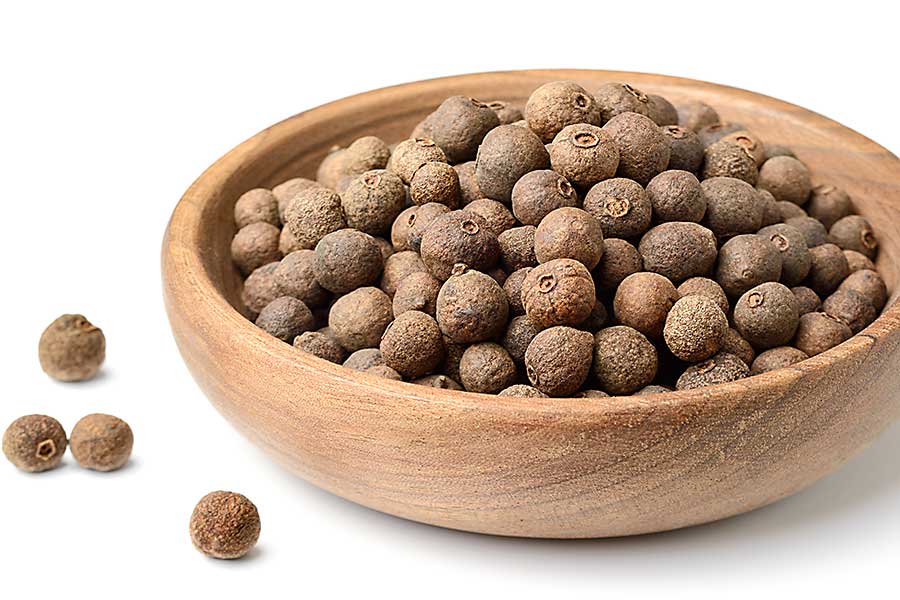Allspice
Allspice, otherwise known as pimento, is a type of spice that is grown only in the Western hemisphere, mostly in the Caribbean, Mexico and Central America. It is an important ingredient in Caribbean, Latin American, and Middle Eastern dishes, used to flavour everything from savoury dishes to desserts and beverages. Because of its name, many people tend to believe that allspice is a combination of different spices. However allspice is simply the dried, unripe berry of the pimento tree.
Where does the term allspice come from?
While allspice is not a unique blend of different spices, it was originally thought to be as such. The spice was discovered by Christopher Colombus on his voyage to the New World, and named by Dr. Diego Chanca. The spice was thought to taste like a combination of cinnamon, nutmeg, pepper, and clove. Thus the name ‘allspice’ was born to capture the flavour of this unique fruit.
Allspice vs peppercorns and pimento
The dried allspice berry is often mistaken for peppercorn due to their extremely similar appearance. However, allspice is larger than peppercorns and has a smoother surface. Because of its other name, pimento, allspice is also often confused with pimiento, a Spanish chilli pepper known for its red colour and heart-shaped form.
Where does allspice come from?
The allspice berry grows on the pimenta dioica, an evergreen tree that grows wild in the forests of Central and South America. The tree is popular in Jamaican cuisine, with almost all parts of it used in their cooking. Allspice is the dried fruit of this tree. The berries are picked while unripe and still green, traditionally dried in the sun. When dry, the berry receives its brown colour and peppercorn-like appearance. In Jamaican cuisine, the fresh leaves of the tree are also used in cooking, with a similar use to bay leaves. The wood and leaves of the tree are also used to smoke meats.
How is allspice used in cooking?
Allspice is one of the main ingredients used in Caribbean cuisine. In Jamaica, it is used in the traditional jerk seasoning, both for flavouring and smoking the jerk. It is also used in pickle seasonings, mole, and as an ingredient in curry powder and sausage. Allspice is another extremely important ingredient in Middle Eastern cuisine, especially food from the Levant region. There it is used as a flavouring for various dishes, from meats to stews, sometimes as the sole seasoning in a recipe. In the US and Great Britain, allspice appears in desserts such as cakes, as well as an ingredient in beauty products. In Poland, you can find allspice in deli meats, pickle flavouring, soup seasoning, and marinades.
You can use both ground and whole allspice for your cooking. The spice is best used freshly ground, as it can quickly lose its pungent flavour the longer it sits as a powder. The fresher it is, the more intense the flavour. Whole allspice is often used in pickling, soups, stews, and as a brine, while the ground version is better in desserts and baking.
Substitutions for allspice
If you’re using a recipe that calls for allspice and don’t have any on hand, you can substitute the flavour by combining equal parts clove, cinnamon, and nutmeg powder. The opposite works, too: if you need to use any of the spices above, substitute with allspice instead.
Private Chefs, Art of Dining
CHEFIN is a private chef platform that’s reimagining social dining.
You can easily connect with 1 of our 250 private chefs and treat your guests to restaurant-quality dining experiences in the comfort of your own home, office or chosen venue. From high-end dining to quirky social food experiences, the CHEFIN platform makes it effortless for you to access gourmet food that’s worthy of a Michelin-starred establishment.
What you get:
-
- Your very own private chef who is vetted and insured,
- A customised menu for your needs,
- 24/7 concierge support,
- Complete post-dinner cleanup,
- A fun, stress-free, and unforgettably dining experience!

